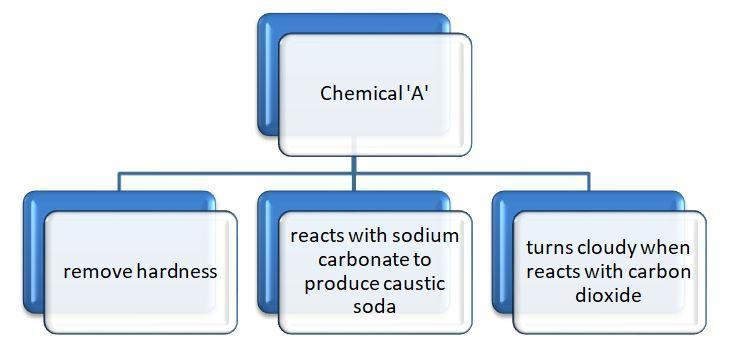Answer
424.5k+ views
Hint: The question can be easily solved when we will draw a step by step chart or flowchart of this question.

Hardness of water is the measure of calcium and magnesium bicarbonates whose hardness can be removed by converting these bicarbonate salts into carbonates.
On reaction with sodium carbonate, it gives its corresponding carbonate.
The milkiness in the solution is due to white coloured precipitate of metal carbonate.
Complete answer: Let us see the properties of chemical ‘A’ to find the common features shown by the chemical.
Property (1)- Use to remove temporary hardness: The hardness in the water is due to high concentrations of magnesium and calcium carbonates, chlorides, bicarbonates and sulphates.
Temporary hardness (bicarbonates of calcium and magnesium) can be removed by boiling and by Clarke’s method:
Clarke's reagent is calcium hydroxide. It removes water hardness by converting bicarbonates to carbonates. The reaction is $\text{Ca}{{\left( \text{OH} \right)}_{2}}+\text{Ca}{{\left( \text{HC}{{\text{O}}_{3}} \right)}_{2}}\to 2\text{CaC}{{\text{O}}_{3}}\downarrow +2{{\text{H}}_{2}}\text{O}$.
Property (2)- Turns solution milky when reacts with $\text{C}{{\text{O}}_{2}}$ : When carbon dioxide gas is passed through lime water, it turns milky because of the formation of calcium carbonate. The reaction is $\text{Ca}{{\left( \text{OH} \right)}_{2}}\left( \text{aq}\text{.} \right)+\text{C}{{\text{O}}_{2}}\left( \text{g} \right)\to \text{CaC}{{\text{O}}_{3}}\downarrow \left( \text{s} \right)+{{\text{H}}_{2}}\text{O}\left( \text{l} \right)$.
Property (3)- Reacts with sodium carbonate to form caustic soda: Caustic soda is $\text{NaOH}$. The reaction is $\text{Ca}{{\left( \text{OH} \right)}_{2}}+\text{N}{{\text{a}}_{2}}\text{C}{{\text{O}}_{3}}\to 2\text{NaOH}+\text{CaC}{{\text{O}}_{3}}$.
The answer to this question is ‘d’. Calcium hydroxide is used to remove temporary hardness of water, reacts with sodium carbonate to form sodium hydroxide and the lime water turns milky when reacts with $\text{C}{{\text{O}}_{2}}$.
Additional Information:
Uses of calcium hydroxide:
(1) Used as a flocculant in sewage treatment plants.
(2) Used as acid neutralizer because it is a weak base and used as a pH regulator in soil.
(3) Used as filler material in rubber and plastics.
Note: The options given in the question are little confusing inter-related, as all the options are the different compounds of calcium. The point is to remember the chemical used to remove temporary hardness. The answer will be much clearer from that only. The temporary hardness is removed by slaked lime ($\text{Ca}{{\left( \text{OH} \right)}_{2}}$) only.

Hardness of water is the measure of calcium and magnesium bicarbonates whose hardness can be removed by converting these bicarbonate salts into carbonates.
On reaction with sodium carbonate, it gives its corresponding carbonate.
The milkiness in the solution is due to white coloured precipitate of metal carbonate.
Complete answer: Let us see the properties of chemical ‘A’ to find the common features shown by the chemical.
Property (1)- Use to remove temporary hardness: The hardness in the water is due to high concentrations of magnesium and calcium carbonates, chlorides, bicarbonates and sulphates.
Temporary hardness (bicarbonates of calcium and magnesium) can be removed by boiling and by Clarke’s method:
Clarke's reagent is calcium hydroxide. It removes water hardness by converting bicarbonates to carbonates. The reaction is $\text{Ca}{{\left( \text{OH} \right)}_{2}}+\text{Ca}{{\left( \text{HC}{{\text{O}}_{3}} \right)}_{2}}\to 2\text{CaC}{{\text{O}}_{3}}\downarrow +2{{\text{H}}_{2}}\text{O}$.
Property (2)- Turns solution milky when reacts with $\text{C}{{\text{O}}_{2}}$ : When carbon dioxide gas is passed through lime water, it turns milky because of the formation of calcium carbonate. The reaction is $\text{Ca}{{\left( \text{OH} \right)}_{2}}\left( \text{aq}\text{.} \right)+\text{C}{{\text{O}}_{2}}\left( \text{g} \right)\to \text{CaC}{{\text{O}}_{3}}\downarrow \left( \text{s} \right)+{{\text{H}}_{2}}\text{O}\left( \text{l} \right)$.
Property (3)- Reacts with sodium carbonate to form caustic soda: Caustic soda is $\text{NaOH}$. The reaction is $\text{Ca}{{\left( \text{OH} \right)}_{2}}+\text{N}{{\text{a}}_{2}}\text{C}{{\text{O}}_{3}}\to 2\text{NaOH}+\text{CaC}{{\text{O}}_{3}}$.
The answer to this question is ‘d’. Calcium hydroxide is used to remove temporary hardness of water, reacts with sodium carbonate to form sodium hydroxide and the lime water turns milky when reacts with $\text{C}{{\text{O}}_{2}}$.
Additional Information:
Uses of calcium hydroxide:
(1) Used as a flocculant in sewage treatment plants.
(2) Used as acid neutralizer because it is a weak base and used as a pH regulator in soil.
(3) Used as filler material in rubber and plastics.
Note: The options given in the question are little confusing inter-related, as all the options are the different compounds of calcium. The point is to remember the chemical used to remove temporary hardness. The answer will be much clearer from that only. The temporary hardness is removed by slaked lime ($\text{Ca}{{\left( \text{OH} \right)}_{2}}$) only.
Recently Updated Pages
How many sigma and pi bonds are present in HCequiv class 11 chemistry CBSE

Why Are Noble Gases NonReactive class 11 chemistry CBSE

Let X and Y be the sets of all positive divisors of class 11 maths CBSE

Let x and y be 2 real numbers which satisfy the equations class 11 maths CBSE

Let x 4log 2sqrt 9k 1 + 7 and y dfrac132log 2sqrt5 class 11 maths CBSE

Let x22ax+b20 and x22bx+a20 be two equations Then the class 11 maths CBSE

Trending doubts
Fill the blanks with the suitable prepositions 1 The class 9 english CBSE

At which age domestication of animals started A Neolithic class 11 social science CBSE

Which are the Top 10 Largest Countries of the World?

Give 10 examples for herbs , shrubs , climbers , creepers

Difference between Prokaryotic cell and Eukaryotic class 11 biology CBSE

Difference Between Plant Cell and Animal Cell

Write a letter to the principal requesting him to grant class 10 english CBSE

Change the following sentences into negative and interrogative class 10 english CBSE

Fill in the blanks A 1 lakh ten thousand B 1 million class 9 maths CBSE



